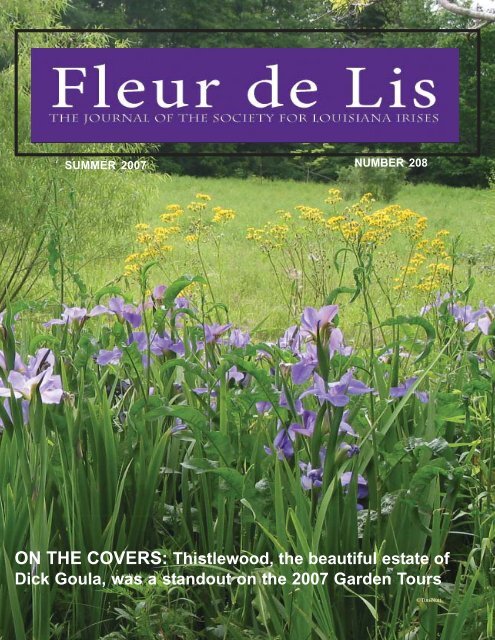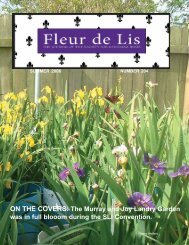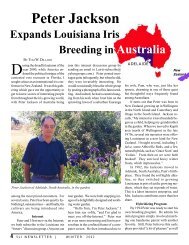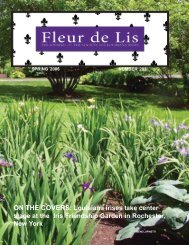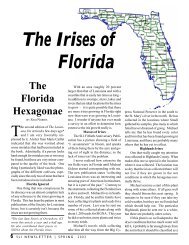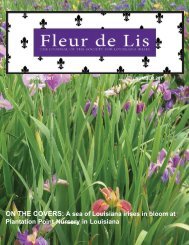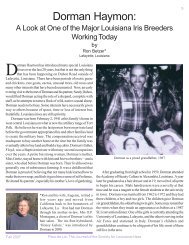You also want an ePaper? Increase the reach of your titles
YUMPU automatically turns print PDFs into web optimized ePapers that Google loves.
SUMMER 2007 NUMBER 208ON THE COVERS: Thistlewood, the beautiful estate ofDick Goula, was a standout on the 2007 Garden Tours©Tim NuttFleur de Lis: The Journal of the <strong>Society</strong> <strong>for</strong> <strong>Louisiana</strong> <strong>Iris</strong>es Summer 2007
Wild <strong>Louisiana</strong>s:Still Out There, Still Beautiful, andMore Endangered Than Everby<strong>Benny</strong> <strong>Trahan</strong>, Sr.Slidell, <strong>Louisiana</strong>3Summer 2007<strong>Iris</strong> nelsonii in its home near Abbeville, <strong>Louisiana</strong>.Like many in South <strong>Louisiana</strong>, I was growing <strong>Louisiana</strong>irises be<strong>for</strong>e I really knew what they were. These plantsare in many gardens, get traded around and often are atotal surprise when they first bloom. In my case some seventeenyears ago, plants dug because of their interesting foliage fromthe yard of my father-in-law’s deceased aunt produced beautifulpurplish blue flowers so impressive that I went to the library tofind out something about them.From my reading I discovered that the unidentified plantswere irises, and specifically <strong>Louisiana</strong> irises. I found it excitingto learn that so spectacular a plant grows wild in the very statewhere I live. Research on the <strong>Louisiana</strong> iris species eventuallyled me back to the swamps and marshes but <strong>for</strong> reasons otherthan hunting and fishing. It has become a passion of mine toseek out and study the remaining wild iris populations.ExplorationEvery year since 1997, I have made many trips into the fieldto see <strong>Louisiana</strong>s growing in their native habitat. Occasionally Itravel great distances, but most excursions are two to five hoursfrom my home in Slidell, <strong>Louisiana</strong>. A few are just an hour away.My longest trip involved two weeks searching throughout Florida<strong>for</strong> I. hexagona.I often go alone on these trips, but I enjoy it when my wifeKathy accompanies me. Kathy does not enter the swamps, butit is nice to know someone is waiting. My oldest son <strong>Benny</strong> Jr.and his wife Debbie almost always make one trip each year withKathy and me to the Abbeville area. We time it to take advantageof peak bloom and to coincide with the <strong>Society</strong> <strong>for</strong> <strong>Louisiana</strong><strong>Iris</strong>es show in Lafayette. My grandchildren like to participatein some of the shorter trips. They enjoy seeing snakes,turtles, alligators, ducks and the irises.We make no rigid plans as to when or where to go, and I amalways searching <strong>for</strong> new areas to explore. I utilize road andtopographical maps and like to google “Earth” on the Internet toview aerial images of the sites I plan to visit and to search <strong>for</strong>promising new ones.We enjoy looking <strong>for</strong> natural hybrids as well as the speciesand are always on the lookout <strong>for</strong> the rare white or yellow iris.We pay close attention to changes in the quantity of bloom andwhether the irises are increasing, decreasing or even disappearingfrom certain areas.Over the years, we have explored a large portion of thesouthern part of <strong>Louisiana</strong>. With a few exceptions, <strong>Louisiana</strong>irises are no longer found in great numbers at any one location.Though plentiful at one time, only small patches remain here orthere in remote locations or in sparsely scattered spots along thesides of roadways. Very few areas offer a view of more than athousand plants. Most of the large patches either are on private<strong>Benny</strong> <strong>Trahan</strong>, Sr. is retired and livesin Slidell, <strong>Louisiana</strong> with his wife of 44years Kathy. They have five childrenand eight grandchildren. His passion<strong>for</strong> his family and <strong>for</strong> <strong>Louisiana</strong> irises,both evident in his article, keep himvery busy.property or they are very difficult to approach.Fleur de Lis: The Journal of the <strong>Society</strong> <strong>for</strong> <strong>Louisiana</strong> <strong>Iris</strong>es
4HabitatsThere’s a lot to be learned from gettingout to see the irises in their native habitats,especially over a number of years. Ithelps clarify the niche of each species, althoughto some extent their habitats overlap.But the natural landscape has beenirrevocably altered by the construction ofroadways, buildings, oil patches, drainagecanals, and irrigation ditches.No species has adapted better tothese changes than I. fulva. Fulvas arefound primarily in low lying open areas suchas the rights of way (servitudes) of utilitycompanies cut through woodlands, oralong the sides of roadways and streamsrunning through wooded areas. Theygrow along the edges of, and to a lesserdegree into, wooded areas <strong>for</strong> a short distance.Most fulvas occur in and along thesides of shallow ditches adjacent to roadwaysand highways. These ditches usuallycontain significant water <strong>for</strong> only briefperiods of time during and after a rain.Fulvas do not like to remain in standingwater <strong>for</strong> long periods, but they do liketheir “feet” planted in moist to saturatedsoil conditions. While I. fulva is found inopen areas, it seems to prefer a locationnear trees which offer partial shade or filteredsunlight. Because man has unknowinglycreated drainage areas ideal as habitat<strong>for</strong> I. fulva, it is now the least endangeredof the five <strong>Louisiana</strong> species.I. giganticaerulea loves water morethan the other species. I have visited manysites where colonies existed on floatingvegetation with their rhizomes and rootsnot anchored to the muddy bottom of theswamp. Along some roadways builtthrough swamplands, I have witnessedgiganticaeruleas extending out three ormore feet from the bank where the waterwas several feet deep. These irises dobest in standing water all year long. Theylike full sun to achieve best bloom, butwhen surrounded by trees they can attaintheir greatest height. Some grow to oversix feet tall.Giganticaeruleas can be found withina few miles of the Gulf of Mexico wherethey are making their “last stand” <strong>for</strong> survival.They do not face good odds <strong>for</strong>continued existence in these areas due tothe loss of fresh water marshlands result-Above: Nelsoniis generally are larger, taller and a deeper red than fulvas, with less of anorange infusion. Below: A variety of I. fulva <strong>for</strong>ms.Fleur de Lis: The Journal of the <strong>Society</strong> <strong>for</strong> <strong>Louisiana</strong> <strong>Iris</strong>es Summer 2007
The White Castle mystery red: A nelsonii <strong>for</strong>m in fulvaterritory.ing from erosion, saltwater intrusion, andpast and future hurricanes. There are otherpopulations of I. giganticaerulea in partsof South <strong>Louisiana</strong> further inland from thecoast that appear to be holding their ownat least <strong>for</strong> the present.I. brevicaulis seems to survive well ineither wooded, shady areas or in full sun.I have found them in pastures among shortgrasses where cattle graze and within deepwoods under old live oak trees.Brevicaulis can’t tolerate as much moistureas the other species, so they are typicallyseen on higher ground with gooddrainage.I. nelsonii is found in a very limitedarea mostly south of Abbeville, <strong>Louisiana</strong>(hence the old name “Abbeville reds”).The nelsonii habitat today is virtually surroundedby sugar cane fields and is on privateproperty. What is left of these beautiesis within swamps of cypress and gumtrees located in small depressions that appearto be two to four feet lower in elevationthan the surrounding cane fields. Theseare narrow bands of swamp usually a halfmile or less in width and one mile or so inlength. The nelsoniis are found in standingSummer 2007shallow water that mayremain present all year.Sunlight still penetratesthe defoliated treecanopy during growingseason and reaches theirises below.I have not been ableto obtain in<strong>for</strong>mation onthe size or the exact locationsof the Abbevillecollecting sites of the1960s. I can onlyspeculate that a muchlarger area was availableto those searching amere fifty years ago.The remaining wildnelsoniis have not yetbeen destroyed by canefarming because of theexpense required to fillin the natural depressions in which theygrow. They also are in prime deer huntingareas. I have no doubt that, un<strong>for</strong>tunately,the I. nelsonii remaining in its wild habitatwill become extinct in the very near future.<strong>Iris</strong> HeavenSome refer to areas around Abbevilleas “iris heaven.” I certainly do. Four ofthe five species can be found within a twomile radius. The conditions are perfect <strong>for</strong>this meeting. The large blue coastal iris, I.giganticaerulea, is located along roadsto the shores of the Gulf of Mexico, lessthan 15 miles from Abbeville. The VermilionRiver runs through the town ofAbbeville heading south towards the Gulfof Mexico. The winding river’s courseincludes swamps and marshes. I am notsure if some of the land in that area ishigher due to the river overflowing its banksand silting over or the possibility of undergroundsalt domes that cause certain areasto be higher in elevation. In any scenario,I. brevicaulis has taken advantageof this circumstance and used the higherground to make a home. I. fulva can befound throughout this area where moistureFleur de Lis: The Journal of the <strong>Society</strong> <strong>for</strong> <strong>Louisiana</strong> <strong>Iris</strong>es5is present in the soil, but water does notcollect on the ground <strong>for</strong> long periods oftime.The prolific presence of these threeirises in their individual but adjacent nichessupports the conclusion that I. nelsonii wasborn as a hybrid. Nelsonii was strongenough and <strong>for</strong>tunate enough to find aniche of its own.What’s Out ThereThere is more variety of <strong>for</strong>m and coloramong the <strong>Louisiana</strong> iris species than manyrealize. Despite extensive destruction ofhabitat, there is much still to be seen. Someof the <strong>for</strong>ms we have found in the past includewhite and double branched I. giganticaeruleaand a nearly six foot tall I.nelsonii. There are fulvas in a far widerrange of colors than generally appreciated,including not only yellow but also examplesthat are orange, pink/purple, and a yellowwith a pink blush. Yellow I. fulva is veryrare. I have only found them in three differentlocations. I have not encounteredany yellow I. nelsonii but it was found inthe past.The more time I spend with <strong>Louisiana</strong>irises in the wild, the more unansweredquestions I have. I do not know why thereis so much variation within all the species.Each new location of a species seems tohave at least some characteristics differentfrom the plants in a previous setting,sometimes prompting questions about theirorigins. The color of the flower, the numberof buds, and the height of the scapeare all different. I. fulva is reported to be24 to 36 inches tall. However, I have observedthem in natural locations reachingheights taller than 48 inches. Fulvas in onespot may have no branching, while in othersthe majority will have one or morebranches. The bud count in some placesis normally three or four, but others haveproduced five and six bud positions perscape. In some locales, the fulva scapehas little or no zigzag pattern, while in othersit is much more pronounced.My most surprising find was nearWhite Castle, <strong>Louisiana</strong>, on the west bank
6In its native setting, there is no mistaking the tall I. nelsonii <strong>for</strong>a fulva.of the River about 30 miles due south ofBaton Rouge. One of my friends told mehe remembered some irises growing in aditch while working in an oil field about20 years ago. The irises in that area shouldbe I. fulva. When I found these irises,some were nearly five feet tall and somehad multiple branches with as many asnineteen flowers on a single scape. Thecolor range was from red to orange with ayellow infusion.The White Castle irises are similar toI. nelsonii, but they were well over onehundred miles from the nelsonii’s Abbevillehome. The location is in a ditch on theside of a sugar cane field. A house is situateda little beyond where the ditch ends,and there are a fewhunting camps downa dirt road. Theirises there are sounique as comparedto any other site thatI have visited that Iinquired at the nearbyhouse, and an elderlylady who had livedthere <strong>for</strong> 30 years reportedthat she knewnothing of the irisesother than that theyhad always beenthere.As to their origin,I can only speculatethat they werecollected from anotherplace andtransplanted somewherealong thedrainage path of thisditch. If transplanted,they mayhave originatedaround Abbeville. Insupport of thistheory, there is an oilpipeline in that area,and the town ofAbbeville has a greatdeal of oil-related activity. It is possiblethat an oil field employee relocated fromthe Abbeville area with his family, and someI. nelsonii accompanied him. I will neverknow with certainty the origin of the WhiteCastle irises, but the stand remains of significantinterest, prompting a few trips thereeach year during bloom season.Is there a clear dividing line betweenfulva and nelsonii? There is a great amountof variation within I. fulva and a lesseramount within I. nelsonii, but fulvas areso much numerous and widespread that isnot a surprise. There is not as much purplein the color range of I. fulva, and not asmuch brick red in nelsonii. Fulva oftenexhibits a yellow infusion (copper appear-Hunting <strong>Iris</strong>es NotFor WimpsMy son <strong>Benny</strong>, Jr. and I haveencountered many types ofwildlife while searching <strong>for</strong> irises inthe wild. Some are beautiful andharmless like herons, wood ducks,pileated woodpeckers, deer, indigobuntings, and blue birds, to name afew. Others are in another category,like alligators and poisonoussnakes.We both have had watermoccasins strike at us and miss,but <strong>Benny</strong>, Jr. has had the closestcalls. On one occasion we werewalking along the bank of a bayoulooking far ahead <strong>for</strong> irises. My sonwas leading and stepped right overa coiled up moccasin sunning itself.He was lucky not to be bitten.Another time he was looking downat some I. fulva, and a nonpoisonousrat snake struck at hisface from the tree above.In our searches we have seenhundreds of alligators, once <strong>Benny</strong>,Jr. was knee deep in murky watertrying to get to some I.giganticaerulea growing in a clearingwhen he noticed an alligator aboutseven feet in length floatingapproximately <strong>for</strong>ty feet away. Thealligator submerged andsubsequently reappeared abouttwenty feet from him. There was noway <strong>for</strong> him to quickly escape themuddy bottom swamp to a safeplace, and he thought the splashingmight give the alligator the idea hewas wounded prey. After a fewminutes of staring at each other thealligator turned and swam away.When he thought the gator was asafe distance from him, hecontinued on to the I.giganticaerulea, which turned out tobe nearly seven feet tall.We keep a change of underwearin the truck <strong>for</strong> just such occasions.Fleur de Lis: The Journal of the <strong>Society</strong> <strong>for</strong> <strong>Louisiana</strong> <strong>Iris</strong>es Summer 2007
8ing parts of New Orleans. Large depositsof wild iris could once be foundon the outskirts of small towns all overSouth <strong>Louisiana</strong>. However, residentialdevelopment expanded into the surroundingareas and the once large massesof iris vanished. Additionally, the oil industryexcavated canals from the Gulfof Mexico through coastal roadways tooil-related business locales in an ef<strong>for</strong>tto gain shorter and quicker routes tosupply offshore drilling. These canalsdissected swamps and marshes, allowingsalt water from the Gulf to enter intoiris habitat, destroying the irises in thoseareas. Swamps were and are beingdrained to create land more suitable <strong>for</strong>agriculture. Airplanes spraying herbicidesvery often overspray the intendedfields, killing the irises growing adjacentto them.Development of roadways and highwaysalso destroys iris habitat. In anef<strong>for</strong>t to save time and money, herbicidesare used to control the growth of weedsalong roadways ditches. It seems asthough the decision has been made thatit is easier and more cost effective topoison grass once every three monthsrather than cut the grass once eachmonth, and the iris generally do not survivethe poisonous solutions.Natural disasters like hurricanes alsodrive salt water into the marshes, killinglarge populations of iris. Katrina had ahuge impact on the Southeast portion ofthe State. The two or three weeks ofstanding salty water killed many of therhizomes. I feel Hurricane Rita actuallyhad a greater impact on the <strong>Louisiana</strong>iris species than Katrina. My son <strong>Benny</strong>,Jr. and I visited the Cameron area duringthe 2006 bloom season of I. giganticaeruleato determine the condition ofthis species. Cameron is the coastalParish that abuts Texas. We did findsome small stands in bloom, but notnearly as many as seen in years past.Giganticaerulea is a very tough speciesand could temporarily rebound. IfSearching in FloridaI. hexagona is the one <strong>Louisiana</strong> species that I have not observed anywherein <strong>Louisiana</strong>. The reason I ventured on a two week search <strong>for</strong> irises throughoutFlorida was curiosity stimulated by what I read in the <strong>Society</strong>’s Fiftieth Anniversarypublication of 1991.Throughout the small book, especially in articles by Dr. John K. Small reprintedfrom the 1930s, Florida cities and towns were mentioned as the location of many of thethen-designated species of irises. These irises arenow classified as I. hexagona, although some dorecognize I. hexagona savannarum as a separatevariety within the species I hexagona. (I.savannarum was one of the old, discarded speciesnames). Even though all the East Coast irises aretoday considered to be I. hexagona, there had tohave been sufficient variety among them to induceSmall to extend several different speciesdesignations.On a Florida map, I highlighted all the placesmentioned in the book and planned the best routesto visit each one of them. I found and collectedsamples of irises in all the sites, except the whiteI. albispiritus that was reported to be near theCaloosahatchee east of Fort Meyers. The bookdescribed the location to be about 12 miles up theCaloosahatche River but, I could not secure a boatto reach this site.On my trip through the interior of Florida Isaw the variety I. hexagona savannarum growingin moist soil in very large fields of several acres.These fields did not appear to hold water so theirises grow under conditions similar to I.brevicaulis in <strong>Louisiana</strong>. In most of the sites inFlorida, the irises were growing next to canals,Forms of I. hexagona collectedin Florida.ditches and streams, similar to the places where I. fulva is found in <strong>Louisiana</strong>. <strong>Iris</strong>esdo not occur in the Everglades.Overall, the Florida irises do favor I. giganticaerulea in many ways, but with somedifferences. The <strong>for</strong>ms I saw are shorter, their color generally is a darker blue, and theleaves appear to be stiffer. I did not see a single white iris in Florida on either of the tripsthere.The largest color difference is in the irises on the west cost of Florida in Dixie andLevy counties. The irises there are the darkest blue I have seen, darker than anygiganticaerulea that I have encountered in <strong>Louisiana</strong>.The shorter height of the Florida irises compared to I. giganticaerulea could be dueto the soil. Florida has a siliceous sand, coarse base, while <strong>Louisiana</strong> has a rich blackmud. This appears to be the most significant environmental difference between <strong>Louisiana</strong>and Florida, and it could account <strong>for</strong> the smaller size of Florida irises.There is a good deal of variation among the Florida irises, but I leave it to theexperts to determine whether they should all be lumped into I. hexagona. I personallydid not find enough variation to warrant the naming of new species.It is difficult to make a direct comparison of Florida and <strong>Louisiana</strong> specimensunder like conditions. The per<strong>for</strong>mance of Florida irises in <strong>Louisiana</strong> is very poor <strong>for</strong>the first year or two, and then they seem to acclimate and begin to bloom. Perhaps intime there will be a better basis <strong>for</strong> conclusions.Fleur de Lis: The Journal of the <strong>Society</strong> <strong>for</strong> <strong>Louisiana</strong> <strong>Iris</strong>es Summer 2007
<strong>Iris</strong> brevicaulis.the missing iris or their seeds survived, theyshould be found a mile or so further northwhere much of the marsh grasses and mudsettled.There are too many reasons why thenaturally growing <strong>Louisiana</strong> iris species willbe extinct in the near future. I predict thatthe first to disappear from the wild will beI. nelsonii, followed by I. brevicaulis, I.giganticaerulea, I. hexagona, and finally,I. fulva.I do not think anything can be done toprotect the <strong>Louisiana</strong> species iris in theirnatural habitat. Their habitat is disappearing,and purchase of some of the remainingland is cost prohibitive. More of thespecies iris should be grown by iris lovers,and as the plantings multiply, whendivision occurs, replanting should be aggressivelypursued in wild areas that couldsupport them. We could give them a newstart under more controlled but naturalisticconditions.Even this approach is risky and didnot work <strong>for</strong> me. For years I had been<strong>Benny</strong> <strong>Trahan</strong>, Sr. with an <strong>Iris</strong> nelsoniiapproaching six feet in height.9planting species irises in the swamps ofBayou Sauvage East of New Orleans.They were developing into fairly largecolonies of red, white, blue, and purpleblooms. Each year I looked <strong>for</strong> naturalhybrids in my planted areas. Un<strong>for</strong>tunately,in the year 2006, they were totally destroyedby Katrina.From my involvement with the species<strong>Louisiana</strong> irises, I have gained agreater appreciation <strong>for</strong> the swamps andmarshes of our State. The serenity andbeauty as well as the dangers are an attractionthat beckons me to return yearafter year. I cannot adequately describethe scene of moss-draped cypress treeswith their knees protruding from the dark,murky water with clumps of large blue orred flowered iris in the background. I wisheveryone could witness this iris in its naturalhabitat.<strong>Louisiana</strong> <strong>Iris</strong>es Take Top Honors at Local Shows<strong>Louisiana</strong> irises do well in irisshows—but only when quality stalksare entered and when judges arein<strong>for</strong>med and not biased in favor ofbearded irises. We are pleased to reportthat a <strong>Louisiana</strong> iris, ‘Henry Rowlan’(Faith 2000), won the Best Specimenaward at the Tulsa Area <strong>Iris</strong> <strong>Society</strong> showin Oklahoma this spring. It was exhibitedby <strong>Society</strong> <strong>for</strong> <strong>Louisiana</strong> <strong>Iris</strong>es presidentPaul W. Gossett of Tulsa. Adding moreto the occasion was the win by another<strong>Louisiana</strong>, ‘Jacaranda Lad’ (H. Pryor96), as First Runner-up. It was exhibitedby Jo Ann Minter. Another <strong>Louisiana</strong> irison the “Queen’s Table” was ‘FrostedMoonbeam’ (H. Pryor 94), which wasexhibited by Paul Gossett, and which wonFourth Runner-up.Carolyn Gif<strong>for</strong>d admires her winning entries, including‘Laura Louise,’ in the <strong>Iris</strong> <strong>Society</strong> of Austin show.Late news out of Texas reports that‘Laura Louise’ (Mertzweiller 90),exhibited by Carolyn Gif<strong>for</strong>d, won the“Best <strong>Louisiana</strong>” category in the <strong>Iris</strong><strong>Society</strong> of Austin show. (Carolyn wonBest Specimen with a tall bearded,‘Cordoba.’) <strong>Louisiana</strong> irises often do wellin the Austin show. Last year ‘AcadianMiss’ (Arny 80) took Best Specimen,while in 2005 it was ‘Cajun Sunrise’(Mertzweiller 92) that reigned supremeIf you know of iris shows in which<strong>Louisiana</strong> irises did well, please contactthe editor at tomd@pgtc.com.Fleur de Lis: The Journal of the <strong>Society</strong> <strong>for</strong> <strong>Louisiana</strong> <strong>Iris</strong>es Summer 2007
10A Gallery of Amazing FulvasThe colors of fulva go well beyond the rangeassociated with the “copper iris.” Specimenshave been found that are red, deepyellow, orange, violet, and pink. Unusualblends have also been discovered, includingthose shown with a gold base and ablush of red. Fulvas outside the reddishrange are rare, however.Summer 2007Fleur de Lis: The Journal of the <strong>Society</strong> <strong>for</strong> <strong>Louisiana</strong> <strong>Iris</strong>es


